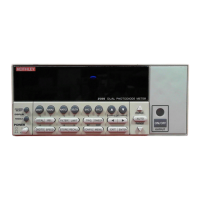13-2 Remote Operations Models 2500 and 2502 User’s Manual
Differences: remote vs. local operation
Local-to-remote transition
When changing from local-to-remote operation the following takes place:
• The Model 2500 stops taking readings and is placed into the IDLE layer of the Trigger
Model.
• All menus are exited.
• All pending front panel commands are aborted.
• The reading buffer is cleared (i.e. FETCh?, CALC1:DATA?, and CALC2:DATA? will
not return any data until the Model 2500 takes readings while in remote.)
• All other settings remain unaffected, including TRACe buffer storage.
• Sources are placed in the FIXed mode.
Remote-to-local transition
When changing from remote-to-local operation the following takes place:
• The Model 2500 stops taking readings and is placed into the IDLE layer of the Trigger
Model.
• All user-defined displays are disabled.
• The display is re-enabled if it was previously turned off.
• Readings are continuously taken.
• Sources are placed in the FIXed mode.
Selecting an interface
The Model 2500 supports two built-in remote interfaces:
• GPIB (General Purpose Interface Bus)
• RS-232 interface
You can use only one interface at a time. The factory interface selection is the GPIB bus.
You can select the interface only from the front panel. The interface selection is stored in
non-volatile memory; it does not change when power has been off or after a remote inter-
face reset.
The GPIB bus is the IEEE-488 interface. You must select a unique address for the Model
2500. The address is displayed when the instrument is turned on. At the factory, the
address is set to 25. The IEEE-488 address can only be changed from the front panel while
the IEEE-488 bus is enabled.
Test Equipment Depot - 800.517.8431 - 99 Washington Street Melrose, MA 02176
TestEquipmentDepot.com

